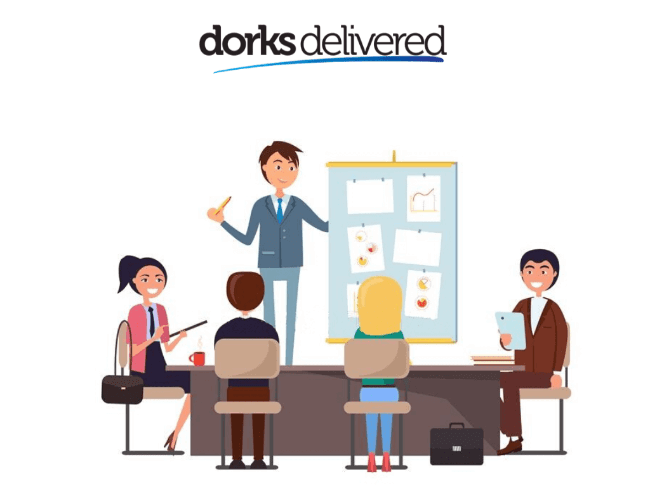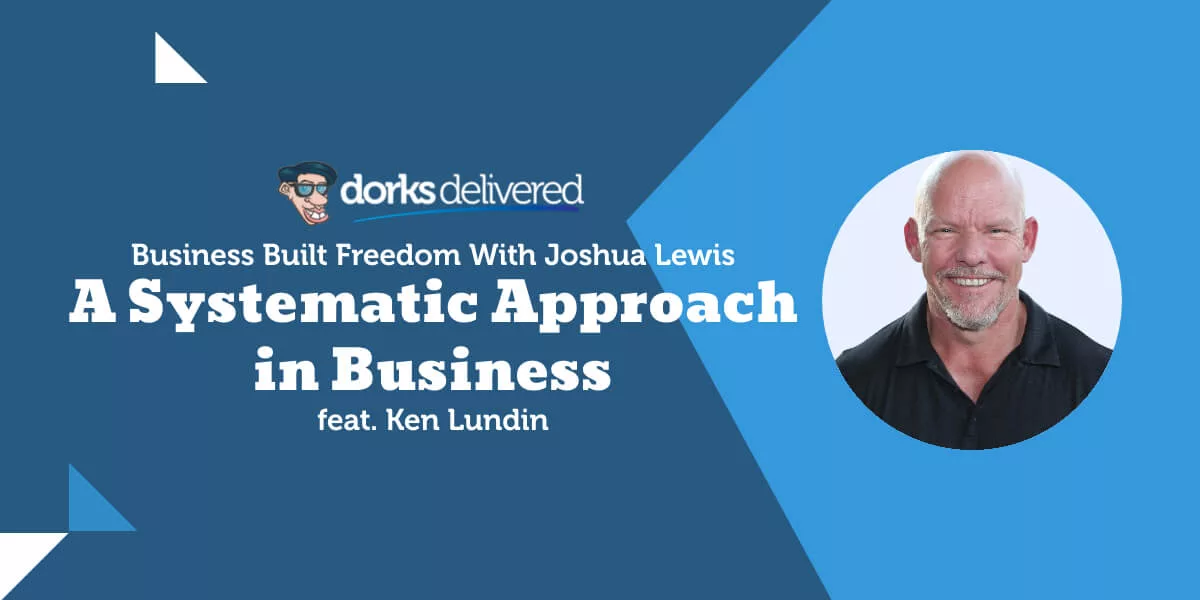A systematic approach in business is a methodical and organised way of approaching business tasks and decision-making. By defining processes, breaking down tasks into smaller components, and establishing procedures and protocols to ensure consistency and efficiency, businesses operate in a more effective and efficient manner.
Ken Lundin joined Josh to share his expertise about having a systematic approach to business and tips on how to further optimise your business.
How to calculate sales growth over five years
What I like to measure is the impact. Do you have an individual who’s in a leadership position or a management position who’s making an impact with what they’re doing? We call that Alpha.
If your industry is growing at 10%, are you growing at above 10%? Because the difference between the industry is just organic growth, and what you’re growing at is the rate that you’re capturing more market share. From that perspective, you’ve got to put the right things in place.
Typically, when we talk about time frames, we ask what are we going to do now? What are we going to do in three months, six months, a year? And then what should we look at in two years. The process of putting sales in place, it’s typically a year’s process with iterations after that.
Probably the number one mistake that companies make is they don’t realise how the product is actually impacting the client or the customer because they think their product matters.
An example of the number one thing that you’ve got to figure out is what’s the big pain that you actually solve? Let’s say you’re selling software or IT services. If you’re trying to sell $50,000 software or a subscription and you’re saying you can give a better report, no executive will wake up one day and think he should spend $50,000 to have a prettier report in a different font.
Executives will spend $50,000 at this moment if that means a way to better run my business with better data and make better decisions that will lead to revenue growth, expense decreasing, etc.
How to Write a Sales Strategy
You can look at it from a couple of perspectives. First, am I doing it right? What are my customer acquisition costs? How much does it require me to get a customer? Second, what’s the lifetime
Ultimately, what we’re trying to figure out is how do we put in a process that’s customer-centric, about solving their problem, and helping them realise the problems they don’t even know they have. One of the biggest fallacies you’re going to see right now is that the buyer is 67% of the way through the journey before they talk to a salesperson.
Here’s the problem: if you believe that in business, you will decide that you no longer must provide value or sell. It’s like going to the doctor because your back hurts, and then the doctor asks you to walk to the door and tells you that you don’t have a back problem, but your knee is messed up. In business, the buyer usually comes in because they’re trying to cure the symptom, instead of the actual problem.
That’s why you must build a sales process that helps the buyer understand how to analyse the problem and how to figure out what the latent pain is, not the pain they walked in with, but what’s the real problem that they need to solve.
Let us handle all of your IT needs so you can focus on your customer’s needs.
How to Help Your Buyer Realise Your Value
We’re in such a hurry to get revenue for the wrong reasons. Early in the cycle of our business called the launch phase, which is about product-market fit, some think they should be producing revenue in order to get feedback.
If you hurry through the product-market fit where you don’t understand the customers’ real problems or issues, when you install the process of sale, you can still sell some stuff but:
- You’re selling it at lower margins
- You have a higher cost of acquisition
- You’re having more stress within the buying cycle
Ultimately, when you start to talk about being efficient about this, it’s the ability to be okay with slowing down to speed up, slowing down to go big.
What Does “Selling on Value” Mean
Hungry Jacks is a perfect example of how you allow commoditisation to happen and what your business may be doing wrong. Think about it: that’s kind of a walk up and take an order—we all
Unfortunately, that’s how the vast majority of businesses in the world present their products. Think about the difference of an experience, though. If you walk in and somebody is going to talk you through it.
That burger at Hungry Jacks might even be better quality than the one that I’m getting down the street from the craft burger place, but they’re asking me what I want, they’re having a conversation with me, and I’m paying almost twice as much for that.
Same thing in B2B sales and B2B servicing. If you want to let the client walk themselves through a do-it-yourself process, you’re going to have commoditisation and price value problems all the time. On the other hand, if you’re going to create a process where you get to have conversations and expose the things that they truly want and need in their business, you can increase your prices and your margins.
Talk to us about automation and top-tier support for your business so you can have more time for your clients.
How to Increase Profitability Ratio

When you talk about the profitability ratio, I think most people are priced too low to begin with because they don’t spend enough time trying to figure out the big problem that’s solved.
If you want to increase your profitability ratio, ask your customers who’ve been with you for any period of time the following questions:
- Why did you originally decide to work with us?
- Why did you decide to buy our products or services?
- What would have you kicking and screaming if we took it away from you?
There’s no one-size-fits-all technology package for business. Find out how you can turn your IT into a utility.
Why Sales Training Can Fail

1. Focus on What You Cannot Control
Focus on what you can control. Oftentimes, we think about our business, and we think about if this would happen, if this could occur, and so on. Focus on what you can control. Push the accountability of what your individual employees or salespeople can control. They can control the number of conversations that they have. They can control the number of first meetings they have.
2. Do Sales Training in Small Bites
Secondly, from a sales training perspective, you must understand that sales training has to be done in small bites. It’s my belief that the world of sales training has failed business.
There’s something called the Ebbinghaus Forgetting Curve, which says that you’ll forget 77% of everything you learn in 7 days. Are you paying people thousands and thousands of dollars to come in for a two-day training course to fix your people? That’s the fire. Burn the cash and then spend it on carrots.
We use a process called Habit Stacking. I got the terminology from somebody else so attribution to whoever it was. We don’t do one- or two-day deals. We do two hours of training in January, two hours in February, two hours in March, and so on.
In between those training sessions, we back it up with coaching to help get the behaviour to change. The number one thing that you need to know about making your team better is it has nothing to do with training. It has everything to do with behaviour change.
If you say, “what can I do to get behaviour change out of my salespeople to make them more successful for our business?”, that will flip your mindset and change the way that you look at how you can increase your sales.
Are you looking for technology that will work with you? We can help!
Change the Way You Buy Sales Consulting
One of the things we figured out a year ago was that people were buying sales training and coaching and they were trying to fix the symptoms. It’s like they’re driving down the road and they have four flat tires, and they were asking us to fix one. But if we change the tire, it’s still a bumpy ride.
What we find is that our sales training and coaching strategy, as well as process work, need to be delivered on a monthly basis. That makes small changes and tweaks because that’s the only way to get long-term behaviour change for your staff, your leadership, etc.
We look at the world very differently. We want to make small changes because we are interested in long-term behaviour change. We try to take a holistic approach.
I have an aversion to calling anything “a service” because it seems like the lazy man’s way out. Everybody is like, “I want to reinvent my business. I’m dry-cleaning as a service.” Suddenly everybody’s got a SaaS business.
What we say is “You get everything we’ve got and it’s a subscription plan for a flat fee.” We’re able to do what would cost about twice as much in total dollars for half as much in monthly spend because we can set it up, we can put our team on it instead of an individual consultant who bills hourly. You call it what you may, but we call it impactful.
https://www.youtube.com/watch?v=MIb42n2yEDY
It’s Okay to Be Wrong
It’s okay to be wrong. It’s okay to fail. That’s something that I learnt after leaving school, which I kick myself for doing so. I remember sitting in the advanced math class after I missed two weeks and I didn’t know what the hell they were talking about but I was too embarrassed to put my hand up to learn. Then I was missing 3 weeks, 4 weeks, and 5 weeks; I was so behind I couldn’t catch back up. If you have a question, ask the question. It’s okay to be wrong. We all do it. That’s something that everyone needs to be more aware of.
Where are vendors’ responsibilities?
At the end of the day, they have a responsibility to represent their product and train the people who sell their product depending on the kind of the lift. As an example, if they are not helping you at all, whatever that product is or the channel partner is, then they should be paying you a lot more than everybody else.
On the other hand, if they’re providing you with a substantial amount of backup, resources and other things, then maybe that’s not the case because they’re investing in your success. I think when I look at our channel partnerships, I’ll take the least amount of money to be a part of the partnerships that I’m most fond of.
Do you want to be efficient? Turn your IT into a utility! Call 07 3166 5465 or book a free discovery session with a dork.
[module-379]































